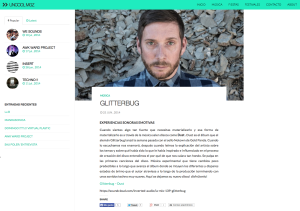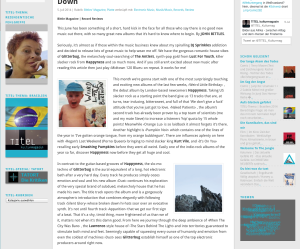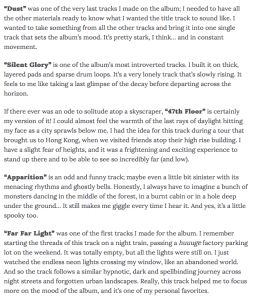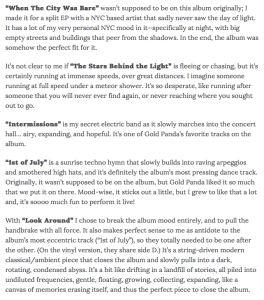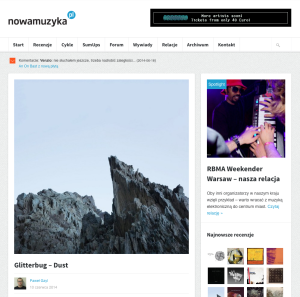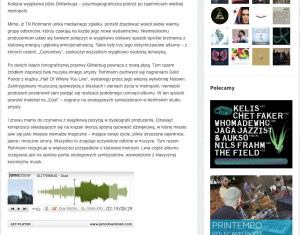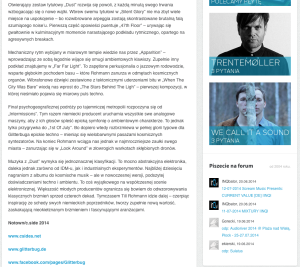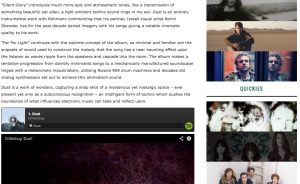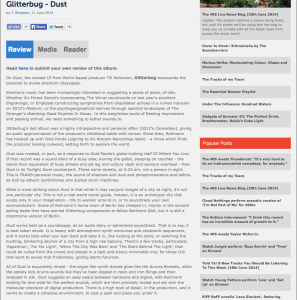 Inverted Audio has been super supportive and very kind to my album. On top of all the lovely things they posted and shared about Dust, they asked me to record a new exclusive podcast for them, and they also did a super long interview. All of that below, or you pay them a visit read it all on their very pretty website.
Inverted Audio has been super supportive and very kind to my album. On top of all the lovely things they posted and shared about Dust, they asked me to record a new exclusive podcast for them, and they also did a super long interview. All of that below, or you pay them a visit read it all on their very pretty website.
***
Tracklist:
1. Ezekiel Honig – Drafting Hindsight (Otherpeople Records)
2. Biblo – Mind You (AENTITAINMENT)
3. Ghostpoet feat. Lucy Rose – Dial Tones (Ritornell Rough Mix) (unreleased)
4. Fluxion – Celestia (Echochord)
5. Murat Tepeli – A2 (Potion001, new label of Prosumer and Murat Tepeli, not yet released)
6. Edit Select – Distant (Prologue)
7. Downliners Sekt – Silent Ascent (InFiné Music)
8. Austra – I Don’t Care (I’m A Man) (Domino)
9. Why Sheep? – Radiation 1 (Karesansui Surrounding Remix) (Third Ear Recordings)
10. Braids – Amends (Full Time Hobby)
11. Tangula – Imbalance (Diametric)
12. Mike Dehnert – Bar2 (Echocord Color)
13. Mary Velo – Silent Hill (Gynoid)
14. Seri (JP) – Switch In My Brain (Acidworks)
15. Sikøra – Diary Lowender (Rough Cut Records)
16. Keith Carnal – Prospect (Affin Records)
17. Glitterbug – Far Far Light (NOTOWN Recordings / c.sides Label)
18. Colleen – Everything Lay Still (Leaf Label)
Last week Berlin based producer Glitterbug released his new album ‘Dust‘ on Gold Panda’s NOTOWN imprint. We were so impressed with the album that we invited him to record a mix and discuss the album in detail.
“I wanted to make an album about remembrance and remains – both in a sense of people and things that were, stories of lives that were lived, the life that filled places before us, about urban shadows and leftovers of the things that were.” – Til Rohmann / Glitterbug
YOU’VE JUST RELEASED ‘DUST’, CONGRATULATIONS! WHAT KIND OF FEEDBACK HAVE YOU BEEN GETTING BACK SINCE IT WAS RELEASED?
Thaaaaanks!!! Thankfully, the press has been overwhelmingly positive throughout. I mean there are always some reviewers that don’t really get it, get some facts wrong, make weird comparisons or just write poorly… but those are a total exception, and it’s been amazing!
The attention is definitely not bothering at all – on the contrary. You sit in the studio for a year or more writing an album, then you wait for the mastering, graphics and final product to be printed – during this long period, all the feedback one gets is from the label, a few close friends and collaborators, but it’s impossible to get a sense of how it will be received. That’s a super nerve-wrecking period. To then have your album released to the world and to see that people can relate to it, and specifically to read what they see in it and where it touches them is super rewarding. I am very grateful that Dust gets this much attention. Considering the amount of music that’s released every week, even in my little musical niche, I am unbelievable fortunate to have this many publications write and speak about it!
As far as letting that shape my music – no, not at all. In early Glitterbug years, when I was still a bit lost and didn’t really have a fully developed sense of artistic direction yet, I sometimes tried to make music that would sound more like this or that, just to be able to fit somehow and somewhere.
But during the period of producing my first album, ‘Supershelter‘, I realised that the only person I can be is actually myself (radical realization, I know…), and that I also can’t change who I am when I am making music. So, for the good and bad – even if I wanted to let public taste and opinion shape my music (which I absolutely don’t), I couldn’t. Being Glitterbug is my biggest stronghold and weak point at the same time, and there is absolutely nothing I can do about it.
CAN YOU TELL ME ABOUT THE CONCEPT BEHIND THE ALBUM? WHAT DO YOU THINK IT REPRESENTS?
Well, in a way it’s both a sequel to my previous album, ‘Cancerboy‘, and since I also conceptually wanted to do something that’s relevant for Notown, I also looked at Gold Pandas last album and took some of the notions of ‘Half Of Where You Live’ to take them a step further and to knit my own stories into the fabric. I wanted to make an album about remembrance and remains – both in a sense of people and things that were, stories of lives that were lived, the life that filled places before us, about urban shadows and leftovers of the things that were. That’s also where the album title, ‘Dust’, stems from.
Cancerboy, by the other hand, was an autobiographical album about life, death, sickness and me and my friend’s personal struggles with cancer. It’s actually an album that I wrote for dead friends, about the stories and experiences that will bind us together forever.
Dust peaks into the shadows and tries to catch a glimpse of what once was. We all have our own personal maps and memories of our surroundings, especially when we lived in the same place for some time. Just imagine the multitude of memories of all humans that once lived in one building, street, city, and try to put that on top of present life. This was the idea behind Dust.
The moodiness and visual qualities of my music for sure have their roots in my past- I was very sick for most of my childhood and definitely marked for my entire adolescence and adult life. I stood out as a very odd being, and I can’t say that I had a very functional family either (both my parents were artists and not very good at parenting, to say the least). Not being happy with your place in life, being an outsider in school (and so forth) pushed me further towards art and music and alternative forms of expression as well as venturing off to imaginary worlds that often felt more welcoming than the real world. I imagined very lonely places mostly filled with friends from the hospital times that passed along the way. I still feel very at home in these places, and they always shine through the surface of my music I guess. The listener can often feel that abyss underneath it all I suppose.
TELL ME ABOUT YOUR ALBUM WRITING PROCESS? WHERE DID YOU SPEND THE MAJORITY OF YOUR TIME WORKING ON THE ALBUM AND WHO WITH?
I started writing Dust when I was still living in Cologne, during my very last months there. I already had left my old studio (the lease had ended), and moved to an intermediate temporary place in a friend’s house (he had a huge 2 story apartment in terrible shape, and he didn’t know what to do with the top floor – so I made it into a studio for a few months), and then I moved to Berlin.
Finding a studio here was actually very difficult, and I was forced to build a basic, temporary studio at home, something I haven’t done in like 10 years or so, and I was reminded why. I hate waking up and to look at my workspace!! I then found a nice studio that I share with Murat Tepeli, one of my closest friends, and my long-term collaborator and one of my favourite visual artists (and humans) on this planet, Ronni Shendar.
So Dust is in fact a true studio album, there wasn’t much traveling involved, just moving studios three times along the process…. I’m sure all that packing, unpacking and moving was also an influence, as it forces one to also pack memories and re-examine places and their meaning.
I work on music pretty much in solitude. I’ve worked in band and ensemble contexts in the past, but it’s not necessarily for me. The fact that I sink very deep into the mood of my music makes me rather socially incompatible with most other humans during production times. So there wasn’t much else I did during that entire period. I also can’t really listen to any other music when I produce. So I’m not only thrilled to be back to social life, but especially enjoying discovering new music.
DO YOU HAVE A FAVOURITE TRACK? IF SO, WHICH ONE AND WHY? I LIKE ‘47TH FLOOR’ – IT SOUNDS A LOT LIKE BIG BEN.
How can I tell you which my favourite is without upsetting the others? No, but seriously, I don’t really know. After I’m done with an album, it’s usually all a big blur and they all become one big blob in my head.
Tracks that stick out for me are ‘Far Far Light‘ for its simplicity, moodiness and minimalist production. ‘47th Floor‘ is a very special one indeed; more of a miniature rather than a full track, and it’s funny that you think that it sounds like Big Ben… I guess I haven’t been to London in too long, I had to Google the sound to remind myself the tonality (and that made me remember that my English teacher in school made us stand up before class and have us sing “Good morning Miss Klein – Miss Klein, Good Morning! In the Big Ben melody)… I also really love ‘The Stars Behind The Light‘ for its despair.
WHEN DID YOU DECIDE TO RELEASE AN ALBUM ON GOLD PANDA’S LABEL NOTOWN? WHY NOT JUST SOLELY UNDER YOUR C.SIDES IMPRINT?
Well, we wanted to do something like this for quite some time, and I guess it was a logical step in the evolution of our labels and music to do this eventually. Derwin at first asked me if I’d like to do an EP for Notown, and I took the entire arm rather than just the little finger (can one say this in English?) and asked him if I could make it into an album… he had to say yes because he is one of the nicest and most polite people I have ever met! Just kidding.
c.sides is a lovely platform and I am super excited about further projects on the label. Up next is a split EP of Jasmine Monique Guffond aka Jasmina Machina and Turkish supertalent Biblo, and the next Biblo album after that.
But it’s also great to have new platforms for your art sometimes, and it’s very nice of Notown to lend me their stage for my music. To always release on your own imprint is lovely, but also limits you to preach to the same choir and to convince the convinced over and over. I hope that through Notown I am able to reach new people with my music that probably haven’t heard of me before, and that’s just wonderful.
WHEN DID YOU FIRST MEET DERWIN AND HOW DO YOU COMPARE YOUR MUSIC ALONGSIDE HIS?
Derwin and I met in a festival in Amsterdam in… I think it was in 2009 or 2010. It was slightly before Gold Panda went on that incredible sky-high ride of success with his music, and we were stuck in a backstage with some incredibly famous people that were annoying as hell and that we both tried to ignore. So there was us, intimidated by and totally uncomfortable with the situation, and we started chatting because that was definitely something we had in common, but we only introduced ourselves with our first names, not our artist names. Derwin then picked up the program and was like: damn, do you know if Glitterbug played already? I really wanted to see him! And I had to answer that yes, we were on yesterday, and hey, that Glitterbug, that’s me! That’s where our friendship started. We both don’t fit into that strange music business all too well, and we both always feel a bit like the odd ones in class. Which we are, I suppose. And that’s one of the reasons we love each other so much.
Derwin and I write and produce music very differently. But where we definitely meet, and in my opinion that’s the most important element in music, is in the mood and atmosphere. We are both quiet sensitive, melancholic and moody people, and that is mirrored in the music we make.
TELL ME ABOUT THE TIME YOU SPENT IN CALIFORNIA WITH RONNI SHENDAR SHOOTING THE VIDEO FOR DUST? I CAN IMAGINE YOU SLEEPING UNDER THE STARS IN A TENT…BUT I FEEL THIS IS FAR BEYOND THE REALITY ON WHAT ACTUALLY HAPPENED.
Oh, shooting in an all-outdoor setting during that period of the year in that area is not so easy, maybe even life threatening… temperatures can get below -20°C at night, with days hot and dry. There’s up to 40°C difference between day and night. Also, it’s incredibly dusty, and especially with film equipment, one has to be careful to not ruin it. Did I mention the venomous critters that live there?
We actually had a great infrastructure and could be out filming during daytime and come back to a warm wooden cabin in the middle of nowhere at sunset. Ronni has some family that lives out there, so we could actually make use of off road buggies to climb up dusty gravel roads into the mountains, and find out about hidden trails for the areas we wanted to film. It was a lot of work, lots of hiking, and lots of carrying equipment- but very rewarding to be able to work in such an incredible environment. And I totally love the outcome.
DID YOU ENVISION THIS TYPE OF ENVIRONMENT FOR THE ALBUM? WHO SUGGESTED IT AND WHERE ELSE WERE YOU THINKING OF SHOOTING THE VIDEO?
I wanted to have an environment as sparse of human life as possible, and no humans in the video for this particular track. It was clear we wanted to shoot Dust in a desert. Ronni had been to the area before, so she knew exactly where and what she wanted to film, and we had the best local guides.
Sadly, we are horribly overwhelmed with work and projects at the moment – but if you stay tuned for a little longer, there will be a second video for a second track of Dust sometimes soon… This time though, it will be strictly urban.
HOW DO YOU THINK YOUR MUSIC CAREER WILL PROGRESS FROM NOW ON?
Well, that’s pretty hard to foresee. What I learned from the past few years is that one can’t and shouldn’t take anything for granted in this field – and I have no idea what the future will bring and how much I will perform, how big of a demand I’ll have or even if there will be any.
I try not to think about that too much and move on, make new music, work on the next album, release music by people I love and admire, and all else is not under my control really. But I love performing! Specifically live with Ronni on visuals, and also as a DJ. It’s an exhausting but rewarding experience, specifically being able to connect directly with an audience and being able to experiment with my music and see it in new light.
IT FEELS LIKE A LOT OF PATIENCE WENT INTO THE ALBUM. CAN YOU TAKE ME THROUGH YOUR STUDIO SETUP, WHAT MACHINES YOU WERE USING AND IF YOU HAVE ANY SPECIAL WEAPONS FOR PARTICULAR SOUNDS?
Well…. It’s just a studio I guess? I think that equipment is the least interesting, and sometimes can be a huge distraction from the core of it, the actual process of writing and creating music! At least that used to be the case for me- the most equipment hoarding I did when I was the unhappiest with my music.
But since you’re asking: I’m a total nut for good audio reproduction, so the first big and important part is proper monitoring. I used my Klein & Hummel O96 monitors for most of the production, but recently upgraded to the wonderful British ATC SCM25’s, which are the best monitors I have ever heard in the near / mid field range. My reference near fields are the good ol’ BBC designed LS3/5a’s, that I have both at home and in the studio, which makes A/B-ing and taking music to different environments a lot easier.
As headphones, I use the rather exotic Jecklin Float (QA), that’s an electrostatic model that originates in the 70s, and that to me is unmatched by anything in the market, at any price point. Those were especially important for the album since I had to move my studio several times and had to get accustomed to different, mostly very silly room acoustics- the Floats saved my life and a lot of time because I had a true and trustworthy reference, no matter where I worked and how obnoxious the room acoustics were. Amping for the passive part and the headphones (they do need a power amp) is done through vintage Quad amplifiers, particularly the 405, 520 and a pair of 510 (the latter I am very proud of!).
When it comes to instruments, it’s a blend of both digital and analog- I am rather pragmatic about these things. Important were a Yamaha CS15, a Cheetah MS6, Logic Studio, Arturia, a Korg Poly 800, a Jomox Airbase, a Roland 909 & Roland MKS80 (both not mine, but shared with Murat Tepeli), some Dave Smith stuff, a Waldorf Blofeld, a lot of little boxes and strange things from the past 40 years of music equipment… and Universal Audio. I have the UAD Apollo Quad and am terribly in love with it, and the UAD platform is basically all I use when it comes to DAW signal processing. I simply wouldn’t be able to afford the same sound with outboard gear.
HOW ARE YOU TRANSLATING YOUR STUDIO SETUP INTO A LIVE SETUP?
Nothing too special here either, but it takes up a lot of space and has a lot of pretty flashy lights and knobs and faders as eye candy for the audience and to keep me busy: I do use Ableton as the main hub and sequencer for both midi and audio (but only for live shows, never in the studio), a lot of dedicated controllers, and some outboard instruments, like a Dave Smith Mopho, a Waldorf Blofeld, a Jomox M-Base, a digital sub mixer and some stomp boxes and external FX. I also use Universal Audio live on stage and have both a Satellite and a Laptop card with me on stage.
WHAT’S THE STORY BEHIND THE NAME GLITTERBUG AND WHAT IS YOUR MUSICAL HERITAGE BUILT UPON? WHAT ARTISTS AND ALBUMS WERE STILL ARE INTO?
Glitterbug stems from the last film Derek Jarman made before he died of HIV. He is (or better, was) one of my most favorite directors and artists out there, and I loved both the name of the film as well as that it was such a personal collage of his life without an obvious narrative. My music is a lot like that I think – you have to grasp intuitively, rather than try to understand it from a rational viewpoint.
My musical roots are very versatile, but reach very deep into experimental music and contemporary classical music of the past 100 years, obviously a lot of electronic music of the past 30-40 years with a big crush on Detroit, and so forth… I think the mix I made for you guys reflects that a little.
My music is build upon mood, texture, emotion and tension; this is also something I always try to find in the music of other people. Be it Grouper, Meredith Monk, Bela Bartok, Terrence Dixon, Scott Walker, Julius Eastman, Olivier Messiaen, or of very current albums, I was very impressed with the latest of Karen Gwyer and Downliners Sekt – and this is just what immediately sprung to mind, the list is endless- I buy a lot of music, I listen to a lot of music, and I am sure that there are a lot of indirect influences of all these records that I have listened to throughout the years. I actually don’t work with sampling a lot, but in an indirect sense, all this music has travelled with me and influences me, even when I am not aware of it.
CAN YOU TELL ME MORE ABOUT YOUR MIX FOR INVERTED AUDIO?
The mix spans across quite a few musical directions – it combines friendly ambient (Ezekiel Honig, Colleen) with abyssal experimental music (Biblo, Why Sheep?) and melancholic dub (Downliners Sekt, Fluxion, Mike Dehnert) en-route to a short excursion into hip-hop remix contests (Ghostpoet’s Dial Tones with a lovely remix of friends that obviously didn’t win), and every now and then, it reaches out to old school acid (Mary Velo and Seri (JP)), good ol’ techno (Edit Select, Keith Carnal), the essence of hard-as-a-nail downtempo Avant-Schranz from Frankfurt (the first Sikora-release in years- and what a track that is!) and incredibly deep techno (Murat Tepeli, Tangula, and my own Glitterbug self), reaching out to some of the most wonderful experimental-ish pop I know (Austra, Braids).
Or to say it in one sentence: it covers a lot of music and moods that I love from the bottom of my heart. In approximately 80 minutes. And to me, none of these tracks are contradictions, and I think they all make perfect sense together.
It sadly doesn’t reach gender parity, but at least it’s 1/3rd female producers in there. It’s a start. The set was recorded ‘live’ in one take, using two Technics 1210 and a vintage Dateq XTC mixer. For tracks that I don’t have or that don’t exist on vinyl, I use one of those silly DJ programs with vinyl control.
Glitterbug’s new album ‘Dust’ is out now. Buy a copy of the album on vinyl, CD or digital via Bandcamp and iTunes.

